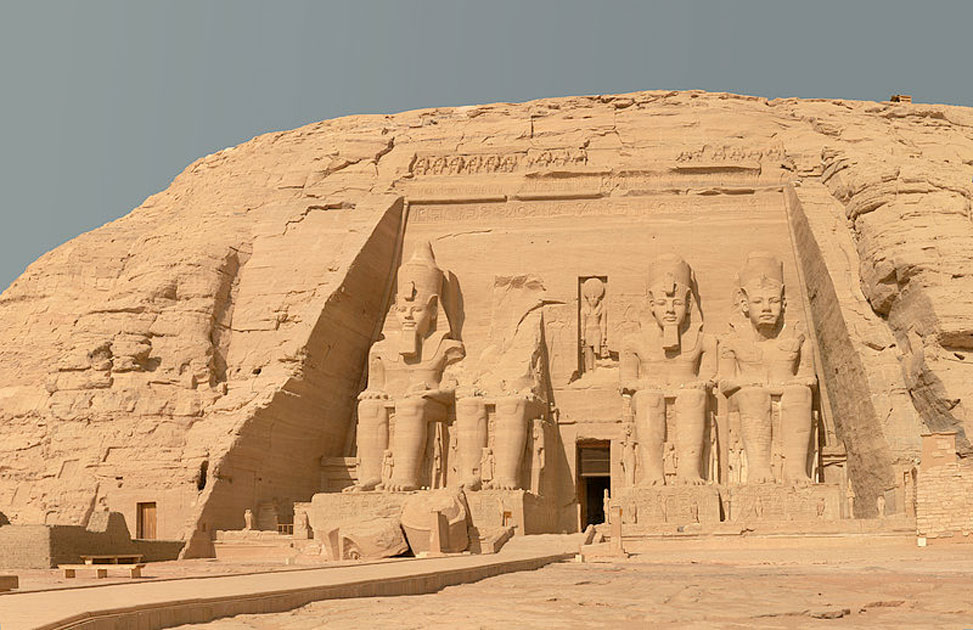The Great Abu Simbel Rescue: The Tale of Two Ancient Temples That Moved Up A Hill
50-years-ago almost to the day, arguably the world’s most complicated archaeological missions concluded after the entire temple complex at Abu Simbel was dismantled, block by dusty block, and rebuilt on higher ground to save it from being flooded by the Nile River.
This monumental UNESCO-led project relocated 20 gigantic stone monuments from the Abu Simbel temple complex in Nubia, in southern Egypt near the border with Sudan, to save them from being submerged by the rising waters of the Nile River. The project officially concluded on September 22, 1968, after an eight year-long international effort involving 1000 workers. Today, we look back at this remarkable feat of heritage protection.

Abu Simbel, Nefertari Temple, Lake Nasser, Egypt. (CC BY-SA 2.0)
Rock Temples of Abu Simbel
At Abu Simbel, two massive rock temples were originally located on the western bank of Lake Nasser, about 230 km (143 miles) southwest of Aswan. The complex is part of the UNESCO World Heritage Site known as the "Nubian Monuments" and the twin temples were originally carved into a mountainside in the 13th century BC, during the 19th dynasty reign of the Pharaoh Ramses II.
The entrance to the larger of the two temples has four colossal statues of a seated Ramses II leading to a succession of rooms and galleries stretching back 63 meters (207 feet). According to a report in Dawn.com this week, in 1968 the two temples were dismantled and relocated in their entirety “to an artificial hill made from a domed structure, high above the Aswan High Dam reservoir.” This maneuver was necessary to save the temples from being submerged during the creation of Lake Nasser, “a massive artificial water reservoir formed after the building of the Aswan High Dam on the Nile River.”

The four Colossus of the Great Temple of Rameses II. (Big Stock Photo)
We Have A Problem. Damn It!
A Live Science article explained how this project came about in the 1950s after Egypt’s then president Gamal Abdel Nasser was inspired to dam the Nile at Aswan “to generate electricity for the region, increase cultivable land and reduce flooding.” His construction plans would require a new artificial lake behind the dam wall which meant the resettlement of tens of thousands of indigenous Nubians from villages in the area, and the temples at Abu Simbel risked being submerged.
- Abu Simbel: This Enormous Temple of the Great Ramesses II Was Buried for 3,000 Years
- Hathor, the Turquoise Goddess Near the Nile
- Owner of Mummified Legs Likely to Be Nefertari, Favorite Queen of Ramses II

The Aswan Dam is an embankment dam situated across the Nile River in Aswan, Egypt. (CC BY-SA 3.0)
Abu Simbel Temple Rescue
In 1960, UNESCO, launched an appeal to save the two temples and asked international contractors to put forward solutions. A Swedish-Egyptian proposal was eventually selected, and the construction of a temporary dam began on April 1, 1964. The two Abu Simbel temples “were cut into 1,035 blocks each weighing between 20 and 30 tonnes” and the four colossal statues of a seated Ramses II, and six more of him standing up, were sawn into pieces. According to the latest Dawn.com article “jacks, cranes and powerful winches hoisted the enormous stone weights to the top of the cliff, 64 meters (210 feet) from their original location” where they were “reassembled to reconstitute the two temples exactly as they were.”
- Would You Like to Tour the Tomb of Nefertari? Grab Your VR Headset and Explore!
- Oldest Recorded Solar Eclipse Helps Date the Egyptian Pharaohs
- Leaving an Impression: Footprints Left by Children Found in Ancient Capital of Ramesses II

The temple of Hathor and Nefertari, also known as the Small Temple, at Abu Simbel. (CC BY-SA 2.0)
After the blocks had been rebuilt on higher ground, artificial hills were built around the site as a protective barrier against the river and for four long years about 1000 specialist construction technicians worked their way through a 36-million-dollar budget, ending on September 22, 1968. The original site is now completely submerged by Lake Nasser and follow-up rescue UNESCO director general Rene Maheu told reporters it was an “unparalleled undertaking, in which over fifty countries... have combined their efforts to save the artistic and historical treasures of the temples of Abu Simbel.”
UNESCO director general Amadou Mahtar M’Bow praised the “wealth of talent, energy, experience and capital” mobilized to save the Nubia monuments. “Nowhere, perhaps, has the sacred art of Egypt defied time so majestically as in Nubia, part of which is vanishing before our eyes today,” he said in the recent Dawn article.
Top image: Great temple moved in the 1960s Abu Simbel temple rescue operation. Source: CC BY-SA 3.0
By Ashley Cowie



















